Content for TS 23.280 Word version: 19.2.0
1…
5…
5.2.8…
6
7…
7.3.2
7.4…
7.4.3…
7.5…
8…
9…
9.2.2…
9.2.2.2…
9.3…
10…
10.1.2…
10.1.3…
10.1.4.3…
10.1.4.5…
10.1.5…
10.1.6…
10.2…
10.2.3…
10.2.4.2…
10.2.4.3…
10.2.5…
10.2.7…
10.3…
10.6…
10.7…
10.7.3…
10.7.3.4…
10.7.3.7…
10.7.3.7.3
10.7.3.8…
10.7.3.10…
10.8…
10.8.4…
10.8.5…
10.9…
10.9.3…
10.9.3.5…
10.9.3.8…
10.9.3.9…
10.9.3.9.3…
10.9.3.9.4…
10.9.3.10…
10.9.3.10.4…
10.9.3.10.6…
10.10…
10.10.1.2.3…
10.10.2…
10.10.3…
10.10.3.3…
10.10.3.4…
10.11…
10.11.5…
10.12…
10.13…
10.13.3…
10.13.7…
10.13.10…
10.14…
10.15…
10.15.3…
10.15.3.3…
10.15.3.4…
10.16…
10.17…
10.17.3…
10.17.5…
11…
11.3…
11.5…
11.5.2…
11.5.3…
11.5.3.3.2A…
11.5.4…
A…
B…
C…
10.10.3.3 Procedures within single MC system
10.10.3.3.1 Ad hoc group emergency alert initiation
10.10.3.3.2 Ad hoc group emergency alert cancel
10.10.3.3.3 Entering an ongoing ad hoc group emergency alert
10.10.3.3.4 Leaving an ad hoc group emergency alert
10.10.3.3.5 Modifying the criteria for determining the participants during an ongoing ad hoc group emergency alert
...
...
10.10.3.3 Procedures within single MC system p. 240
10.10.3.3.1 Ad hoc group emergency alert initiation p. 240
Figure 10.10.3.3.1-1 illustrates the procedure for the MC service client initiating an ad hoc group emergency alert initiated by an authorized MC service user.
Pre-conditions:
- The MC service user at MC service client 1 wants to send an ad hoc group emergency alert to the MC service users who are satisfying certain criteria.
- All MC service clients belong to the same MC system.
- The MC service user on MC service client 3 is authorized to receive ad hoc group participants information.
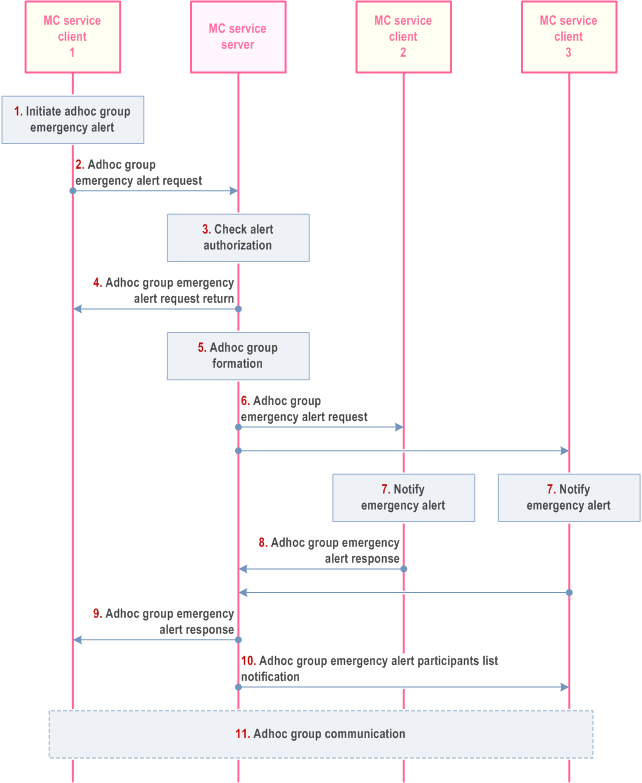
Step 1.
The MC service server shall resend an ad hoc group emergency alert request towards MC service client(s) who still satisfy the criteria but did not acknowledge the ad hoc group emergency alert.
The MC service server continuously checks whether other MC service clients meet or if participating MC service clients no longer meet the criteria for the ad hoc group emergency alert.
The MC service user at the MC service client 1 initiates an ad hoc group emergency alert to an ad hoc group with participants satisfying specific criteria. The MC service user may add additional information describing the reason for sending the alert.
Step 2.
MC service client 1 initiates the ad hoc group emergency alert by sending the ad hoc group emergency alert request containing the details of the criteria to be applied by the MC service server for determining the participants list or the list of participants. MC service client 1 may set its MC service emergency state. The MC service user at MC service client 1 may select a functional alias used for the MC service group emergency alert. If MC service client 1 is in MC service emergency state, the MC service emergency state is retained by the MC service client 1 until explicitly cancelled.
Step 3.
MC service server checks whether the MC service user of MC service client 1 is authorized for initiation of ad hoc group emergency alerts and whether the request is supported. The MC service server checks whether the provided functional alias, if present, can be used and has been activated for the user.
Step 4.
The MC service server sends the ad hoc group emergency alert request return to the MC service user 1 containing the result of whether the ad hoc group call is authorized or not. If the ad hoc group emergency alert request is not authorized, the MC service server and the MC service client 1 shall not proceed with the rest of the steps.
Step 5.
The MC service server determines the list of participants to be invited for the ad hoc group emergency alert based on the information present in the information element Criteria for determining the participants. This information element could carry either criteria or indicator identifying the criteria or combination of both. The MC service server stores the ad hoc group ID together with the list of participants for the duration of the ad hoc group emergency alert. The MC service server considers the alerted participants as implicitly affiliated to the ad hoc group.
Step 6.
The MC service server sends an ad hoc group emergency alert request including the ad hoc group ID towards the MC service clients 2 and 3.
Step 7.
MC service users are notified of the ad hoc group emergency alert. The functional alias of the MC service user initiating the ad hoc group emergency alert and additional information related to the alert may be displayed.
Step 8.
The receiving MC service clients send the ad hoc group emergency alert response to the MC service server to acknowledge the ad hoc group emergency alert.
Step 9.
The MC service server sends the ad hoc group emergency alert response to MC service client 1 to inform about successful alert establishment, containing the ad hoc group ID (generated by the MC service server in the case where the MC service ad hoc group ID created by the MC service client 1 is not acceptable or the case where the MC service ad hoc group ID was not provided by MC service client 1).
Step 10.
The authorized user on MC service client 3 is notified with the total list of MC service IDs of those MC service users who belong to the ad hoc group and a separate list of MC service IDs of MC service users who belong to the ad hoc group that have not acknowledged the ad hoc group emergency alert.
Step 11.
10.10.3.3.2 Ad hoc group emergency alert cancel p. 242
Figure 10.10.3.3.2-1 illustrates the procedure for the MC service client cancelling an ad hoc group emergency alert associated with an ad hoc group i.e., MC service users on MC service client 1, MC service client 2 and MC service client 3 belong to the same ad hoc group.
Pre-conditions:
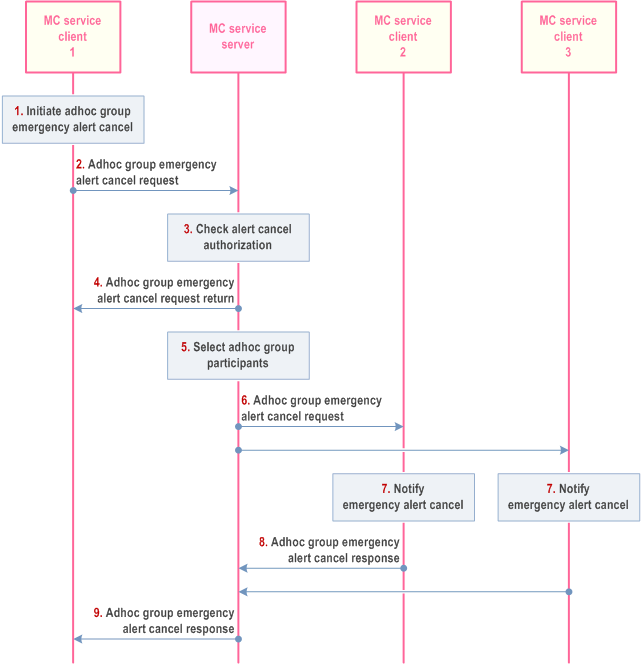
Step 1.
The MC service user at the MC service client 1 initiates an ad hoc group emergency alert cancel to inform the MC service server that alert is to be cancelled.
Step 2.
MC service client 1 sends an ad hoc group emergency alert cancel request to the MC service server. If the cancel request is for another MC service user that initiated this emergency alert, that user's MC service ID shall be included in the request.
Step 3.
MC service server checks whether the MC service user of MC service client 1 is authorized for cancellation of ad hoc group emergency alerts and whether the request is supported.
Step 4.
The MC service server sends the ad hoc group emergency alert cancel request return to the MC service client 1 containing the result of whether the ad hoc group emergency alert cancel is authorized or not. If the ad hoc group emergency alert cancel is not authorized, the MC service server and the MC service client 1 shall not proceed with the rest of the steps.
Step 5.
MC service server uses the ad hoc group ID to select the participants of that ad hoc group. If MC service client 1 has initiated the ad hoc group emergency alert and its MC service emergency state is set, then the MC service emergency state is cleared.
Step 6.
The MC service server sends an ad hoc group emergency alert cancel request towards the participants of the ad hoc group associated with the ad hoc group emergency alert.
Step 7.
MC service users are notified of the ad hoc group emergency alert cancellation and the MC service emergency state is cleared.
Step 8.
The receiving MC service clients send the ad hoc group emergency alert cancel response to the MC service server to acknowledge the ad hoc group emergency alert cancel.
Step 9.
The MC service server sends the ad hoc group emergency alert cancel response to MC service client 1 to inform about successful alert cancellation.
10.10.3.3.3 Entering an ongoing ad hoc group emergency alert p. 243
During an ongoing ad hoc group emergency alert, the MC service server continuously checks if additional MC service users meet the conditions of the ad hoc group emergency alert.
As illustrated in Figure 10.10.3.3.3-1 MC service client is added to the ad hoc group as the MC service client meets the criteria for receiving an ongoing ad hoc group emergency alert.
Pre-conditions:
- An ad hoc group emergency alert has been initiated and the related ad hoc group exists.
- The criteria for entering an ad hoc group emergency alert are known to the MC service server.
- The MC service user on MC service client 2 is authorized to receive ad hoc group participants information.
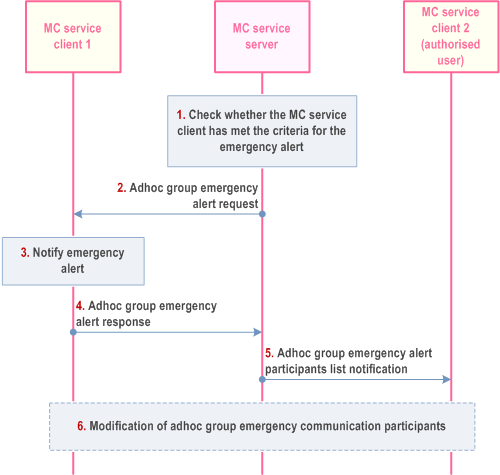
Step 1.
MC service server acquires the latest information of the MC service user at the MC service client and checks whether the criteria for initiating an ad hoc group emergency alert to the MC service client are met. The MC service server considers the MC service client 1 to be implicitly affiliated to the ad hoc group associated to the emergency alert.
Step 2.
The MC service server sends an ad hoc group emergency alert request notification to MC service client 1 to notify that it has moved into potential danger. The MC service client 1 is added to the emergency ad hoc group.
Step 3.
MC service client 1 notifies the MC service user about the ad hoc group emergency alert.
Step 4.
The receiving MC service client 1 sends the ad hoc group emergency alert response to the MC service server to acknowledge the ad hoc group emergency alert.
Step 5.
The authorized user on MC service client 2 is notified with the total list of MC service IDs of those MC service users who belong to the ad hoc group including the newly added MC service client 1, and a separate list of MC service IDs of MC service users who belong to the ad hoc group that have not acknowledged the ad hoc group emergency alert.
Step 6.
10.10.3.3.4 Leaving an ad hoc group emergency alert p. 244
During an ongoing ad hoc group emergency alert, the MC service server continuously checks if MC service users still meet the conditions of the emergency alert.
As illustrated in Figure 10.10.3.3.4-1 MC service client is removed from the ad hoc group associated with an ongoing ad hoc group emergency alert as the MC service client does not meet the criteria for the alert any longer and the emergency alert is removed from the MC service client.
Pre-conditions:
- An ad hoc group emergency alert has been initiated and the related ad hoc group exists.
- The MC service server is aware of the criteria for leaving an ad hoc emergency alert.
- The MC service user on MC service client 2 is authorized to receive ad hoc group participants information.
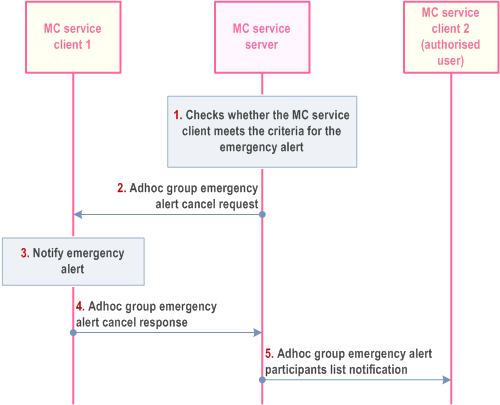
Step 1.
MC service server acquires the latest information of the MC service user at the MC service client 1 and checks whether the criteria for the ad hoc group emergency alert are still met. The MC service server deaffiliates the MC service client 1 from the ad hoc group associated to the emergency alert.
Step 2.
The MC service server sends an ad hoc group emergency alert cancel request to MC service client 1. The MC service client 1 is removed from the ad hoc group.
Step 3.
MC service client 1 notifies the MC service user that the emergency alert is cancelled.
Step 4.
The receiving MC service client 1 sends the ad hoc group emergency alert cancel response to the MC service server to acknowledge that the ad hoc group emergency alert is cancelled for this MC service user.
Step 5.
The authorized user on MC service client 2 is notified with the MC service IDs of those MC service users who are currently in the ad hoc group after removing MC service client 1 from the list.
10.10.3.3.5 Modifying the criteria for determining the participants during an ongoing ad hoc group emergency alert |R19| p. 245
During an ongoing ad hoc group emergency alert, an authorized user modifies the criteria for determining the list of participants of the ad hoc group emergency alert. The MC service server checks whether additional MC service users meet the modified conditions or whether other MC service users don't meet the conditions any longer.
As illustrated in Figure 10.10.3.3.5-1 MC service client 2 is added to the ad hoc group as the MC service client 2 meets the modified criteria for receiving an ongoing ad hoc group emergency alert, whereas MC service client 3 is removed from the ad hoc group as the MC service client 3 does not meet the modified criteria for receiving the ongoing ad hoc group emergency alert.
Pre-conditions:
- The MC service user on MC service client 1 is authorized to modify the criteria for determining the list of participants by the MC service server.
- Both the MC service server and the MC service client 1 are aware of the criteria related to the ongoing ad hoc group emergency alert.
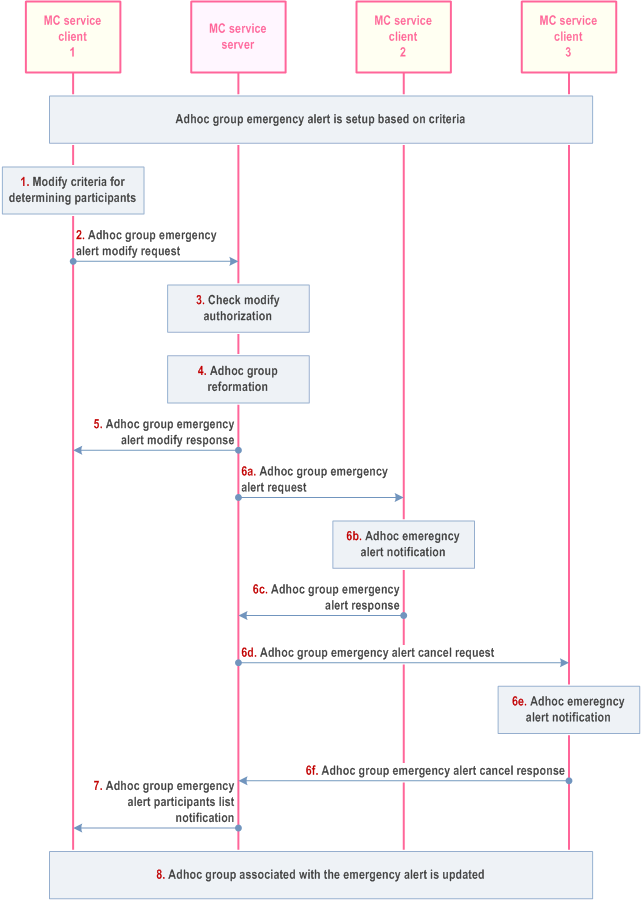
Step 1.
The MC service server continuously checks whether other MC service clients meet or if participating MC service clients no longer meet the criteria for the ad hoc group emergency alert.
The MC service user at the MC service client 1 is authorized and wishes to modify the criteria for determining the list of ad hoc group emergency alert participants.
Step 2.
The MC service server receives the ad hoc group emergency alert modify request.
Step 3.
The MC service server checks whether MC service client 1 is authorized to modify the criteria which determines the list of ad hoc group participants.
Step 4.
The MC service server sends the ad hoc group emergency alert modify request return to MC service client 1 containing the result of whether modifying the criteria for determining the participants of the ad hoc group is authorized or not. If the ad hoc group emergency alert modify request is not authorized, the MC service server and the MC service client 1 shall not proceed with the rest of the steps.
Step 5.
The MC service server analyses the modified criteria and identifies that MC service client 3 does not meet the modified criteria while MC service client 2 meets the modified criteria. The ad hoc group is updated with the determined user list as a member of the group.
Step 6.
The MC service server sends an ad hoc group emergency alert modify response back to MC service client 1, which indicates whether the modify request was successful.
Step 7a.
MC service server sends an ad hoc group emergency alert request towards MC service client 2.
Step 7b.
The MC service user 2 is notified of entering an ongoing ad hoc group emergency alert.
Step 7c.
MC service client 2 sends an ad hoc group emergency alert response towards MC service server.
Step 7d.
MC service server sends an ad hoc group emergency alert cancel request towards MC service client 3.
Step 7e.
The MC service user 3 is notified of leaving an ongoing ad hoc group emergency alert.
Step 7f.
MC service client 3 sends an ad hoc group emergency alert cancel response towards MC service server.
Step 8.
The authorized user on MC service client 1 is notified with the MC service IDs of those MC service users who are currently in the ad hoc group including the new criteria. This notification may be sent to the authorised MC service user by the MC service server more than once during the alert when MC service users join or leave the ad hoc group.
Step 9.
The MC service server adds MC service client 2 to the ad hoc group emergency alert and removes MC service client 3 from the ad hoc group emergency alert.